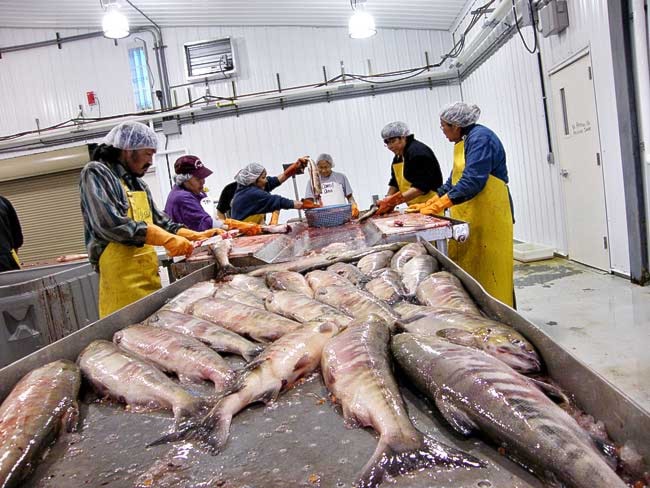The jury is still out on the Yukon salmon run, despite tougher regulations in Alaska.
“We are optimistic,” said Steve Smith, acting area chief for resource management with the Yukon region of the Department of Fisheries and Oceans. “It’s just not entirely clear to us what impact the US restrictions have had on the run. It will obviously have a positive impact, but we’re not sure to what extent. It’s really too early for us to tell.”
The Alaskans have implemented “periods,” or schedules of time that subsistence fisherman are not allowed to fish. These closures follow the run up the river.
“To their credit, they managed in-season,” said Smith. “It’s the early fish that are the higher percentage of Canadian origin. The focus is to try and protect that front end of the run.”
This year, with even lower numbers than the pre-season predictions, each district endured about 10 days of a no-fishing ban, said Steve Hayes, Yukon River Area Manager with the Alaskan Department of Fish and Game.
“Last year we had no restriction on subsistence fisheries,” he said. “We should be doing better than we did last year.”
In 2010, the US did not meet its escapement goal for the number of chinook to reach Canada. According to an international treaty between the two countries, a certain number must get through to reach the spawning grounds.
The challenge for Alaskan managers is permitting equal access all along the river. This is largely a matter of timing and is further complicated with the run of summer chum that move at the same time as the chinook.
In hopes of conserving the chinook, chum fisheries - in desperate need of food and employment - are being forced to stay closed while workers watch their livelihood swim by in record numbers.
“The community is just dying,” said Gary Nelson, co-owner of Yukon River Gold, a commercial chum fishery in the tiny, remote village of Kaltag, Alaska. “They were so disappointed when they heard we were not going to operate. I’ve talked to a couple of the elders and they said this is devastating.”
For about 70 people in the Athabaskan village, 725 kilometres upriver, the small fishery and processing plant is their only livelihood.
Like many Yukon River villages, Kaltag is completely dependant on salmon.
Most of the employees are high school-aged and say leaving the village and their families and elders behind to find work elsewhere is not an option.
Suicide rates in Kaltag range from six to nine times the national average.
The Alaskan Department of Fish and Game hasn’t allowed any commercial fisheries in the Kaltag area to start operating yet.
But it’s not profitable for Nelson to start fishing any later than the last few weeks of June, he said, so he has decided to close the fishery for this season.
Nelson understands the goal is to conserve the chinook.
That is why he is so upset.
Yukon River Gold works entirely with fish wheels.
Not only do fish wheels comb the top water, close to the shore, where it is most common to find chum or young chinook, but they also allow a nearly 100 per cent release rate, said Nelson.
“With any type of fishing method you’re going to have a mortality rate on released fish,” said Smith. “Any kind of fishing apparatus induces stress on fish. I wouldn’t say it is agreed that fish wheels are one of the better methods.”
“That commercial fishery is still going to kill some kings,” said Hayes. “And when you close subsistence you’re saying that we have to protect every one of those kings going through. You cannot have a commercial fishery going on when you’ve shut down subsistence fisheries. Subsistence is the priority.”
But there have been commercial chum openings at the mouth of the river this year.
And they don’t use fish wheels, which allow better separation and survival for any bycatch, or accidental catch, of chinook, said Nelson.
Last year commercial chum openings at the river’s mouth saw a bycatch of around 10,000 chinook.
This year, the bycatch count is already around 4, 000, said Hayes.
But this year, Alaskan regulators have made it illegal to sell any chinook bycatch.
Chinook can sell for a couple hundred dollars a fish, or $35 to $50 per pound.
In Canada, this year’s run regulations haven’t changed from the pre-season plan, said Smith. Commercial and domestic chinook fisheries will remain closed, the chinook sport quota is 0 and the First Nations fisheries are unrestricted, he said.
And even though the annual migration has already made it from the Bering Sea to Dawson City it is too early to tell how good, or bad, the numbers really are.
This is partly due to unreliable sonar machines that can be knocked out of whack by something as simple as high water.
The sonar counters aren’t the only things that need to be fixed in order to manage Yukon River salmon, said Nelson.
“This river has to have a commercial fishery on chums and it certainly has to take a different slant on how it’s operated and managed,” he said. “We should be able to have a commercial fishery and employ people. It’s been pretty devastating.
“It’s all about survival,” he added. “I think other fisheries in the state of Alaska are more balanced in management of one species versus another. This is one strain that just has a horrible management system.”
Contact Roxanne Stasyszyn at
roxannes@yukon-news.com
